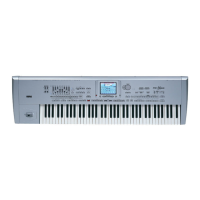103
Style Record mode
Style Import/Export
Reference
accompaniment sequences (string, guitar, piano or other accom-
paniment instruments).
Just to summarize, when you play a chord on the chord recogni-
tion area, the arranger determines which Style Element is used,
then determines which Chord Variation should be used for the
played chord, then Style sequences for every track of that Chord
Variation are transposed from the original chord to the recog-
nized chord using the NTT, and so on every time you play a
chord.
What to record
Recording a Style is a matter of recording tracks, inside a series
of Chord Variations, inside a series of Style Elements, inside the
Style itself.
You don’t need to record all Chord Variations for all Style Ele-
ments. It is often only needed to record just a Chord Variation
for each Style Element. Exceptions are the Intro 1 and Ending 1,
where we suggest to record both a Major and minor Chord Vari-
ations.
Pattern data vs. track data
While the Style Record mode is where you can create or edit
music patterns for the Style, track parameters (like Sounds, Vol-
ume, Pan, Octave Transpose, FX settings…) have to be edited in
Style Play mode.
• After creating or editing music patterns in Style Record
mode, save them by selecting the Write Style command
from the page menu of the Style Record mode (see “Write
Style dialog box” on page 123).
• After editing track parameters in Style Play mode, save
them to the Style Performance by selecting the Write Style
Performance command from the page menu of the Style
Play mode (see “Write Style Performance dialog box” on
page 99).
Style Import/Export
As an alternative to creating Styles on the Pa1X, you can use
Korg’s Style To Midi application to import a Standard MIDI
Files (SMF) from your computer to a Pa1X’s Style. The applica-
tion is freely downloadable from www
.korgpa.com. Please read
the included instructions.
Entering the Style Record mode
While in the Style Play operating mode, press the REC button.
The following page will appear in the display:
• Select Record/Edit Current Style to edit the current Style.
If it is a Factory Style, you may not be able to save it at the
original location (depending on the status of the “Factory
Style and Pad Protect” parameter, see page 272); you will
select a User Style instead.
When editing an existing Style, the original Style Perfor-
mance is recalled, but the following parameters are reset to
their default values: Drum Mapping (Off), Kick & Snare
Designation (Off), Original Style Sound (On), Keyboard
Range (On). This means that you can hear some differences
between the Style in play and the same Style being edited;
for example, resetting the Drum Mapping may lead to
some instruments being replaced.
• Select Record New Style to start from a new, empty Style. A
default Style Performance will be recalled. When finished
recording, you will save the new Style onto a User Style
location. (Styles can be saved onto Factory Style locations
only when the “Factory Style and Pad Protect” parameter is
set to On – see page 272).
After editing the Style, please save it (see “Exit by saving or delet-
ing changes” below) and exit the Style Record mode. Then, while
in Style Play mode, edit the Style Performance to adjust track
settings (Tempo, Volume, Pan, FX Send… see page 84 and fol-
lowing in the “Style Play operating mode” chapter) and save it by
selecting the “Write Current Style Performance” from the page
menu (see “Write Style Performance dialog box” on page 99).
Note: After a record or edit operation, the memory is automati-
cally reorganized. Therefore, when you press START/STOP
there is a delay before you can actually listen to the Style. This
delay is higher with a Style containing more MIDI events.
Note: While in Record mode, the footswitch and EC5 pedals are
disabled. On the contrary, volume/expression-type pedals can
be used.

